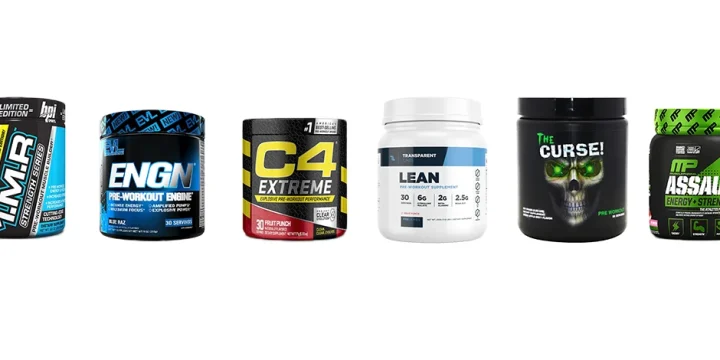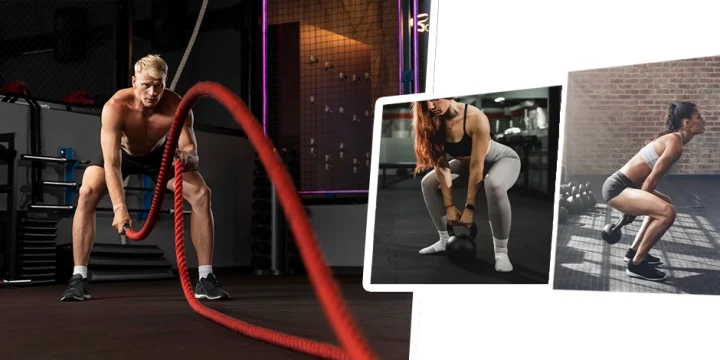The prisoners who perform prison workouts are enclosed in a 3 m squared cell or a simple outdoor playground.
Prison workouts aren’t only push-ups, pull-ups, squats, and endless burpees.
That’s why I decided to shed light on this topic and create the ultimate prison workout you may perform anywhere.
Based on my 19-hour research and a deep dive into the dangerous waters of deadly prisoners, I singled out the best exercises you must include in your prison workout.
Quick Summary
- The best prison workout includes dips, push-ups, step-ups, Hindu push-ups, handstand push-ups, planks, squats, pistol squats, alternating lunges, burpees, and more.
- Some of the most notable benefits of prison workouts are they are entirely free, you can do them anywhere, and people of all experiences can perform them.
- Harvard Medical School study showed that 10 weeks of prison workouts improved aerobic capacity by 33% and muscle endurance by 11%.
- In my opinion, prison workouts are an excellent solution for maintaining fitness and strength, especially in situations with limited access to traditional gym equipment.
What Is a Prison Workout?

A prison workout is a fitness routine typically carried out by inmates using minimal equipment, often relying on bodyweight exercises due to space and resource limitations.
However, in some instances where prisons allow the use of equipment, exercises with external resistance are performed too.
My investigation demonstrated that prison workouts, essentially a form of calisthenics, involve creative bodyweight exercises that can be performed in confined spaces like cells.
Some prisons even have fully-equipped lifting gyms where prisoners can access a pull-up bar, flat benches, etc.
However, most prison exercises include jumping jacks, prisoner squats, push-up variations, bodyweight squats, and burpees.
You May Also Like: Charles Bronson Workout PDF
The Prison Style Workout

As mentioned, prison-style workouts usually consist of calisthenic exercises to induce muscle growth and activate multiple or sometimes only a single muscle group.
Mostly, you won’t need to perform any warm-ups before a bodyweight-based workout, but if you are a beginner, look at the dynamic warm-up below to avoid injuries.
Dynamic Warm-up
Here is a simple dynamic warm-up to perform before every prison workout to avoid injuries and strains:
- Foam Rolling - use a foam roller for every major muscle group, including calves, hamstrings, glutes, thoracic back, quadriceps, and adductors. Roll the foam roller from 15 to 30 seconds for each muscle group.
- PNF Stretching - use PNF, proprioceptive neuromuscular facilitation, and stretching techniques for your hamstring, adductors, and quadriceps. When you reach the end range of motion, activate your antagonist's muscle and then release and go further into the stretch. Repeat for six reps for each muscle group or a stretching exercise.
- Raise Body Temperature - use a treadmill, elliptical or jump rope to warm your body. You must warm your body to make your muscles more flexible, increasing the joints' range of motion.
- Dynamic Warm-up - complete a couple of bodyweight dynamic warm-ups, including high-knees, butt kicks, "4" stretch, walking lunges, and similar exercises. Don't overcomplicate, but aim to do exercises for each major muscle group and movement pattern.
- Activation - complete two glute bridges, dead bug, and scapular push-ups.
Depending on the intensity of your prisoner workout, this comes in handy for increasing the workout performance, decreasing the chance of injury, and making you ready for what's coming ahead of you regarding the preparation of your central nervous system.
"Bodyweight workouts are stellar for stripping down your routine and getting back to basic compound movements. They allow you to build strength while improving your muscle memory and coordination."
- Kirsten Yovino, Certified Personal Trainer
Bodyweight Prison Workout Routine

Below you may find the entire prison workout routine you may complete in the comfort of your home.
Our professionals tested all exercises, and we provide clear instructions for performing each of them.
1. Dips
Drawing from my experience, dips have proven to be exceptional for building upper body strength.
My team discovered that they intensely activate the triceps, anterior deltoid, and lower pectoral muscles, making them a staple in our routine.
How to Perform Dips:
- Assume a starting dip position with a quality parallel bar where your elbows are fully extended.
- Start the exercises by lowering your body between the parallel bars.
- This is done by flexing your elbows.
- Hold this position for one second when your chest reaches the level of the bars.
- Reverse the motion to return to the starting position.
2. Push-Ups

Push-ups are upper-body calisthenics exercises following the horizontal push movement pattern.
They will activate muscles such as all major pectoral fibers, anterior deltoid, and triceps brachii.
How to Perform Push-Ups:
- Assume a starting push-up position with your elbows fully extended and shoulders in the anatomical position.
- Anatomical position requires 60 degrees abduction, 45 degrees flexion, and 30 degrees internal rotation.
- Start by lowering yourself to the ground.
- This is done by flexing your elbows and extending your shoulders.
- Hold the position for a second when your chest reaches just above the ground.
- Reverse the motion by extending your elbows and flexing the shoulder to return to the starting position.
3. Step-Ups
Step-ups are a combination of lunges and regular single-leg squats.
They will activate the glutes, hamstrings, quadriceps, and hip flexors.
How to Perform Step-Ups:
- Assume standing in front of the box or any other elevated surface.
- Start the exercise by stepping on with your right foot on the box.
- Push through your right foot and elevate your body above the box.
- Step back down and repeat with the left leg using the same principles.
- Step-ups can be completed on each leg, depending on your alternating training methodology.
4. Hindu Push-Ups
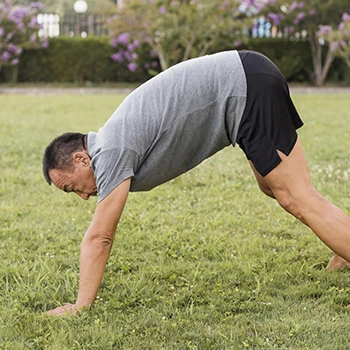
Hindu push-ups are a variation of regular push-ups and are excellent for progressing and making a move more difficult.
They will activate your deltoid muscles, pectoral major, and triceps brachii.
How to Perform Hindu Push-Ups:
- As explained before, assume a regular push-up position with your hands in the anatomical position under the push-up section.
- Start the exercise by shifting your body weight backward and extending your elbows while keeping both arms above your head and on the floor.
- Lower yourself to the floor and move forward until you reach the abdominal stretch position.
- Reverse the motion to return to the starting position and repeat.
5. Handstand Push-Ups
Handstand push-ups are the last pushing exercise on our list that will activate the same muscles as the ones from push-ups and additional lateral deltoids.
Handstand push-ups belong to the vertical push movement pattern.
How to Perform Handstand Push-Ups:
- Assume a handstand push-up position.
- Start by bending your elbows and adducting your shoulders until your head approaches the floor.
- Reverse the movement to return to the starting position and repeat.
6. Planks
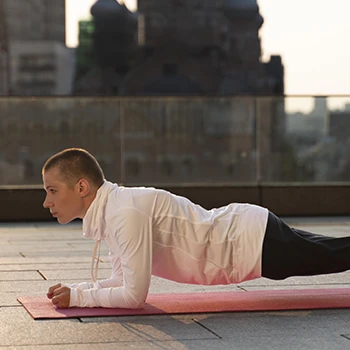
Plank are the core exercise that will develop your rectus abdominis, obliquus internus, and obliquus externus.
It is an excellent exercise for teaching your trunk to prevent movement.
How to Perform Planks:
- Assume an elbowed plank position with your back flat.
- Bread normally and keep your core and glutes tight.
- Hold the plank position for up to 45 seconds.
7. Squats
Squats are the foundational exercise for developing your lower body strength.
They will activate your glutes, hamstrings, quadriceps, and hip flexors.
How to Perform Squats:
- Assume a standing position is wider than shoulder-width apart.
- Start by lowering yourself to the bottom squat position.
- Hold that position for a second when your thighs reach parallel to the ground.
- Reverse the motion to return to the starting position and repeat.
8. Pistol Squat

Pistol squats are a single-leg version of regular squats.
They target the same muscles as bilateral squats but require more work from your stabilizer muscles.
How to Perform a Pistol Squat:
- Assume standing on your right leg while keeping the left leg slightly bent.
- Start the exercise by squatting down on your right leg and extending your left leg forward on the way down.
- When you reach the bottom position, reverse the motion to return to the starting position by extending your knees and hips.
9. Pull-Ups
Pull-ups follow a vertical pull movement pattern.
They will activate latissimus dorsi, trapezius, and biceps brachii.
How to perform pull-ups:
- Assume a hanging position on the pull-up bar.
- Start the exercise by pulling yourself above the bar.
- Stop when your chin reaches above the bar.
- Slowly return to the starting position and repeat.
10. Burpees
Burpees are a combination of jumps and push-ups.
They will activate almost all muscles of your body and improve your conditioning.
How to Perform Burpees:
- Assume a standing position, feet shoulder-width apart.
- Start by lowering yourself down to complete a push-up and then come back up to perform a single jump.
- Repeat for the desired amount of reps.
Where Did the Prison Workout Come From?
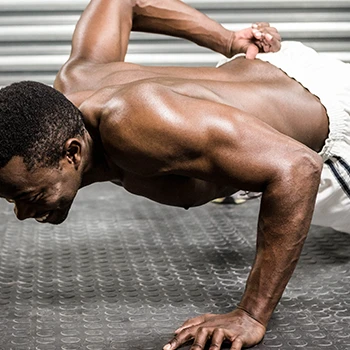
The prison workout originated from Charles Bronson, a notorious criminal in England, who popularized it through intense exercise sessions during his time in prison.
Bronson had a history in bare-knuckle boxing and would indulge in intense prison workout sessions during his years in prison.
Bronson developed his exercise methods aiming to hit the whole body with different upper and lower-body exercises.
A prison workout aims to become jacked and make your entire body as strong and enduring as possible.
However, increasing your strength through a bodyweight workout can be challenging.
Most of the time, squats, push-ups, and pull-ups will be enough to hit multiple muscle groups and develop a certain amount of strength and hypertrophy.
Juarez Valley Method
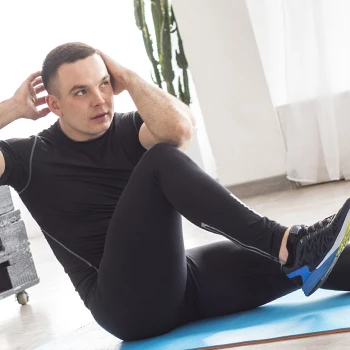
Prisoners use a specific rep scheme for their bodyweight workouts and exercises in the most notorious and dangerous Mexico prison, Juarez Valley Prison.
To do this rep scheme, your entire workout must consist of a single exercise.
If you plan to work out the entire body, you must spread this workout during the day since it will be too intense to perform together.
The whole circuit consists of 20 sets, and the entire rep scheme looks like this:
- Set 1 - 20 Reps
- Set 2 - 1 Rep
- Set 3 - 19 Reps
- Set 4 - 2 Reps
- Set 5 - 18 Reps
- Set 6 - 3 Reps
- Set 7 - 17 Reps
- Set 8 - 4 Reps
- Set 9 - 16 Reps
- Set 10 - 5 Reps
- Set 11 - 15 Reps
- Set 12 - 6 Reps
- Set 13 - 14 Reps
- Set 14 - 7 Reps
- Set 15 - 13 Reps
- Set 16 - 8 Reps
- Set 17 - 12 Reps
- Set 18 - 9 Reps
- Set 19 - 11 Reps
- Set 20 - 10 Reps
On the odd sets, you start up from 20 reps and down a single rep every next set—the same counts for the even sets.
In total, you are completing 210 reps of a single exercise.
You may walk up to ten steps between each set, but the goal of this method is to complete it as fast as possible.
This will build the most significant amount of endurance and strength if you choose compound exercises such as push-ups, pull-ups, or squats.
"The push-up is one of the most basic and effective moves for improving upper body strength. And it really couldn’t be easier to do. You get on all fours, keep your back straight, and repeatedly lower yourself down and up — working the chest, triceps, and shoulders."
- Brad Baldwin, Certified Strength & Conditioning Specialist
Mike Tyson Squat Workout
This squat routine from Mike Tyson workout isn't that hard, but it can become challenging if you modify it by adding additional cards.
Namely, you place ten cards in a straight line, one after the other, and leave 4 inches of space between each of those.
Come to the first card, squat down, and pick it up.
View this post on Instagram
Now come to the second card and place the first one on it.
Squat down and pick the first card, then squat down and pick the second card separately.
This time you have two cards in your hand.
Go to the third card, squat down, and place one card, squat one more time and place the second card.
At this point, you have no cards left in your hands.
Squat down three times separately while picking the card on the top so you end up with three cards in your hands.
Repeat the process until you finish with all ten cards.
Benefits of the Prison Workout

Below you may find the most notable benefits of prison workouts.
1. It’s Free
All prisoner workouts are free since most exercises require your body weight.
You may perform these exercises without spending money on a gym membership or an expensive workout program.
Also, there is no need to buy extra fitness equipment if you don’t plan to do pull-ups or other exercises requiring special setups.
2. You Can Do It Anywhere
Prison workouts can be performed anywhere.
You may perform them in the comfort of your home, in the park, or at a local commercial gym.
You need a little space, preferably a few meters squared.
3. Any Fitness Level Welcome
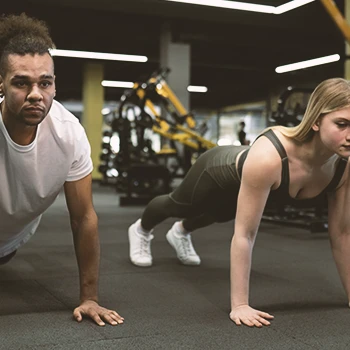
It doesn’t matter if you are already an experienced lifter, a calisthenics expert, or a total beginner.
Based on the article published by the Harvard Medical School, prison workouts are mostly bodyweight exercises, meaning anybody can perform them [1].
You must take care of the volume and intensity you pick for each workout to avoid injury.
4. Strength and Cardio Combined
Prison workouts involve complex exercises such as burpees, jumping jacks, and air squats.
Those become great for exercising your strength and cardio simultaneously.
To truly do cardio, you will need to lower the intensity of the exercise to perform it for longer periods.
Based on a study published by the National Institutes of Health (NIH), anything short in nature is done with anaerobic energy sources, which isn’t considered cardio [2].
FAQs
What Workouts Are Done in Prison?
Bodyweight workouts are done in prison. However, some prisons provide lifting gyms for prisoners, meaning they can perform exercises such as bench presses, barbell squats, and curls.
How Do Prisoners Get So Buff in Prison?
Prisoners get so buff in prison by completing insane amounts of sets and reps over a long period. This amount of work builds muscle memory, enhances hypertrophy, and increases strength over extended periods.
How Do You Stay Fit in Prison?
You stay fit in prison by hitting all major muscle groups daily. Prisoners complete giant sets and reps of regular bodyweight exercises daily to stay in the best shape possible.
What Should I Supplement to Get Buff Like Prisoners?
To get buff like prisoners, you should consider supplementing with protein powder, particularly whey or casein, to aid muscle recovery and growth during the crucial post-workout anabolic window.
Protein powders, whey, and casein are excellent for helping your body build muscle when ingested during the anabolic window.
An anabolic window is a time after a workout when your muscle cells require glycogen and protein to fully rebuild and recover the muscle.
Read or guide on the best protein powders for men to pick the one that will suit your needs the best.
Let me know what your favorite prisoners' workout is and why.
References:
- https://www.health.harvard.edu/exercise-and-fitness/the-advantages-of-body-weight-exercise
- https://pubmed.ncbi.nlm.nih.gov/2402211/
About The Author
You May Also Like




